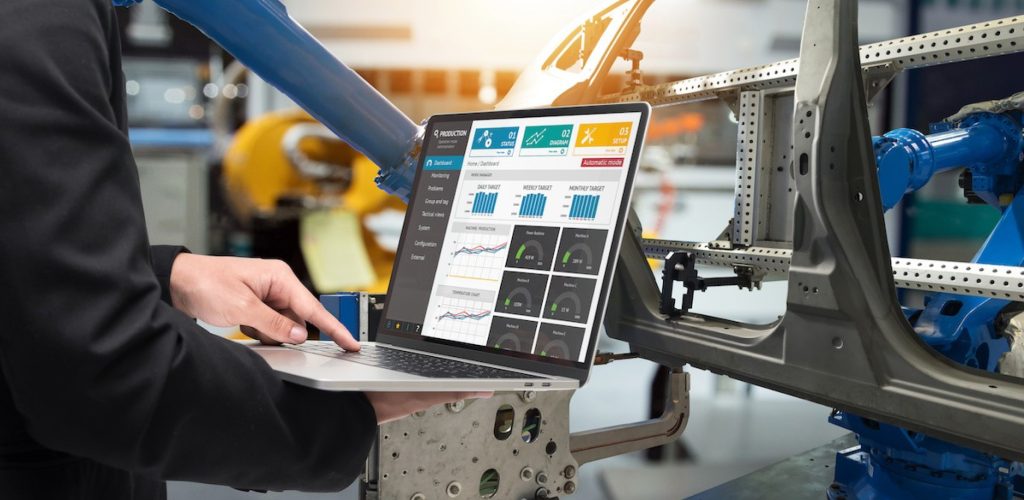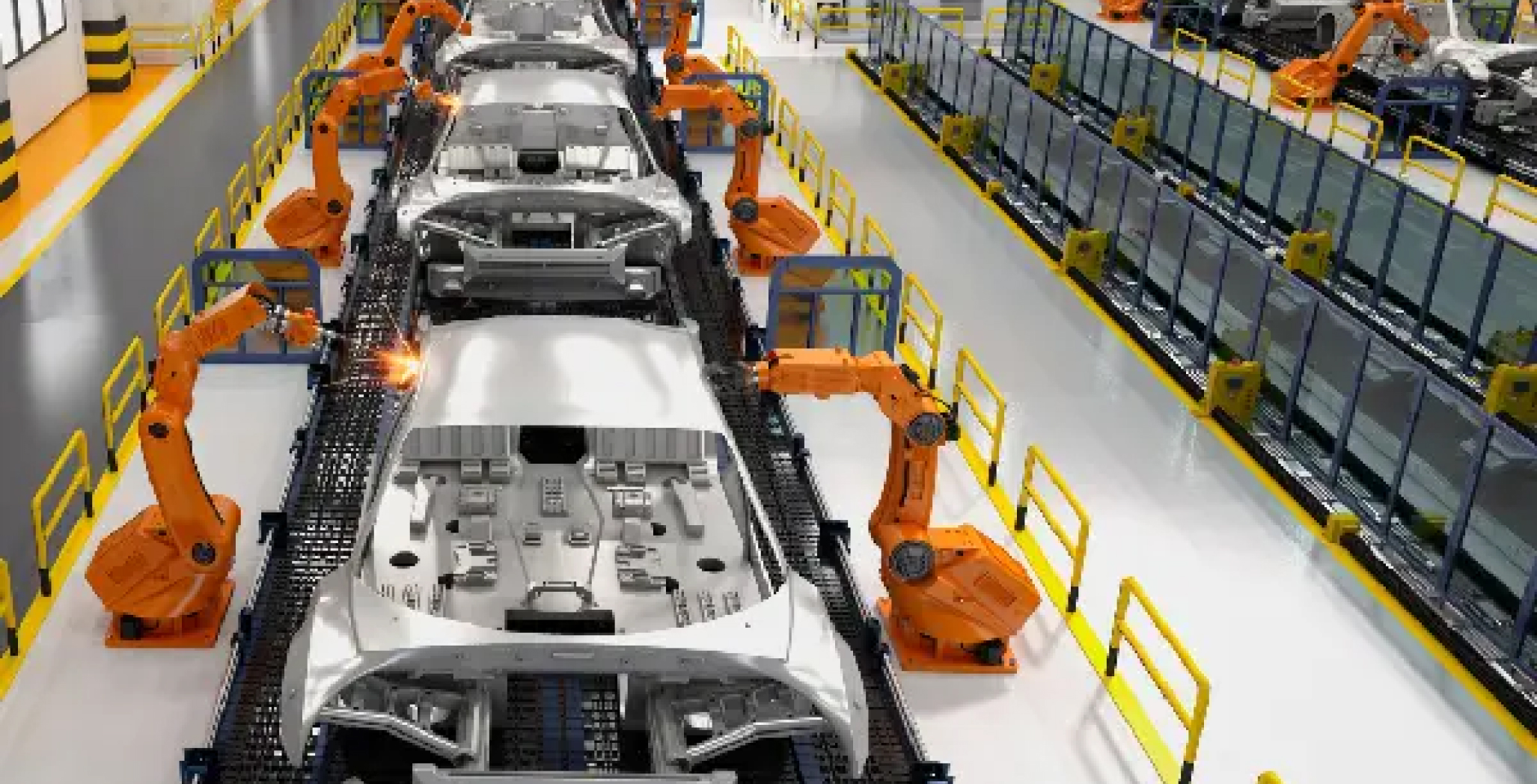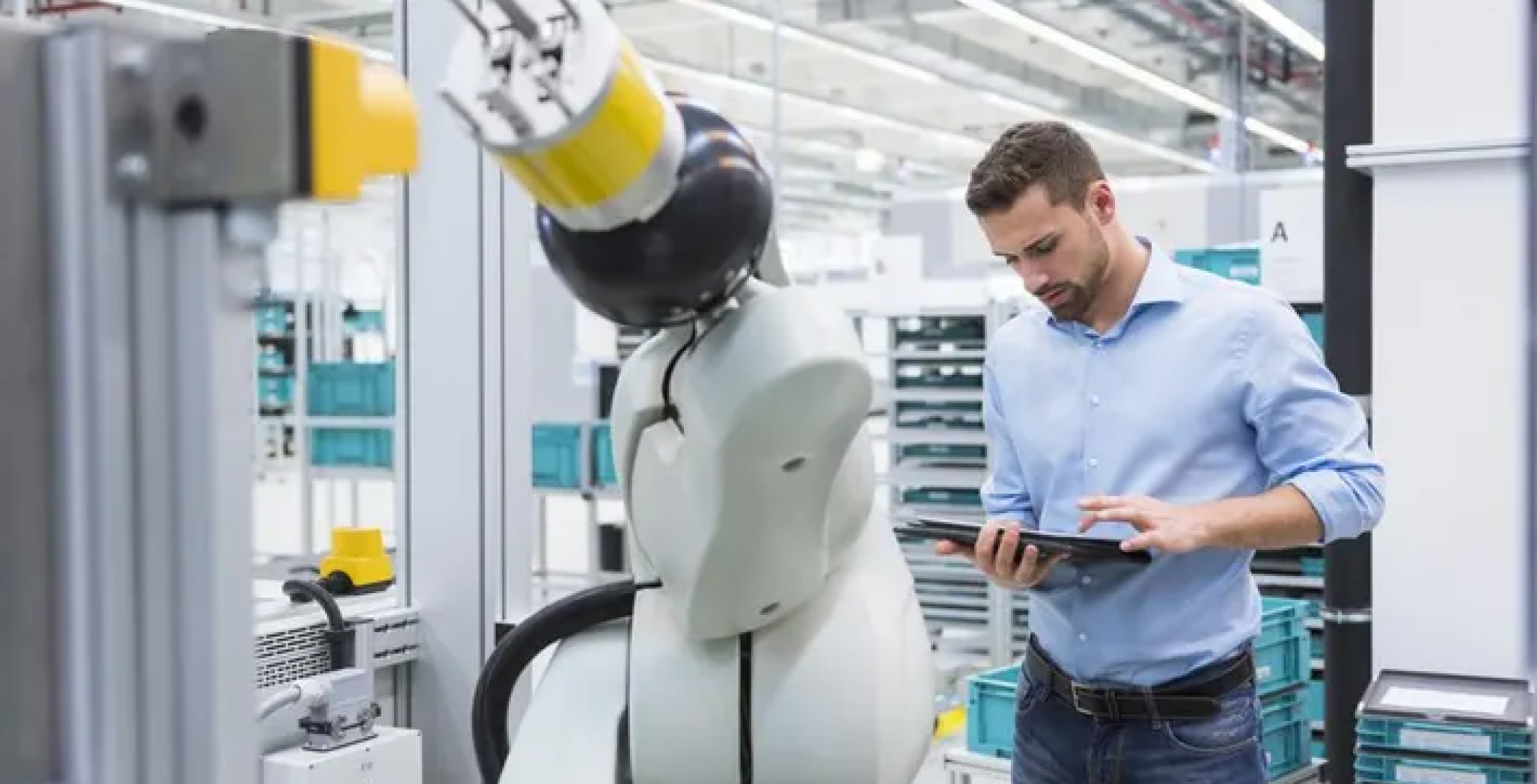The Rise of the Machines
How Industrial IoT is Revolutionizing Manufacturing

The factory floor is no longer just a scene of whirring machines and hard hats. The Industrial Internet of Things (IIoT) is ushering in a new era of intelligent manufacturing, where machines talk to each other, generate valuable data, and optimize processes in real-time. This isn’t science fiction; it’s the present, and it’s revolutionizing how things are made.
How IIoT Works its Magic
1. Predictive Maintenance
Taking a proactive approach to equipment health
Imagine a factory where machines aren’t just running, they’re talking. Sensors embedded throughout the equipment collect real-time data on vibration, temperature, energy consumption, and other key metrics. This data is then fed through powerful analytics powered by the Industrial Internet of Things (IIoT). This creates a shift from reactive maintenance (fixing things when they break) to a proactive approach called predictive maintenance.
How IIoT fuels predictive maintenance:
Sensor network
A network of sensors strategically placed on critical machinery continuously monitors performance. These sensors track parameters like:
- Vibration levels that might indicate bearing wear
- Temperature fluctuations that could signal overheating components
- Changes in energy consumption that could suggest inefficiencies or impending failure
Real-time data collection:
Advanced analytics
Machine learning algorithms analyze the collected data, identifying patterns and trends that indicate potential problems. These algorithms can learn from historical data of equipment failures, creating a digital fingerprint of normal operation. Deviations from this fingerprint can trigger warnings.

Benefits of predictive maintenance with IIoT
Minimized downtime
Extended machine life
Reduced maintenance costs
Improved safety
2. Smart Production Lines
Traditionally, production lines have functioned as a series of independent machines performing specific tasks. IIoT disrupts this siloed approach, transforming them into smart production lines where machines become interconnected and collaborative.
The Power of IIoT in Action
Machine-to-Machine Communication
Sensors embedded in each machine continuously collect data on performance parameters like temperature, pressure, and product dimensions. This data is then communicated wirelessly or through a network to a central control system or even directly to other machines.
Real-Time Adjustments and Feedback Loops
Advanced Analytics and Machine Learning
The data collected from various machines is fed into powerful analytics engines. Machine learning algorithms can analyze this data in real-time, identifying trends and potential issues. This allows for:
- Predictive maintenance: As discussed earlier, anomalies in sensor data can predict equipment failures before they happen, allowing for proactive maintenance scheduling.
- Process optimization: By analyzing production data, inefficiencies in the line can be identified. Bottlenecks can be addressed, and production parameters can be fine-tuned for optimal output and quality.

Benefits of Smart Production Lines with IIoT
Streamlined Production
The seamless communication and collaboration between machines enable a smooth flow of materials and products throughout the line. This reduces delays and bottlenecks, leading to increased production efficiency.
Reduced Errors
Real-time data and automated adjustments based on sensor readings minimize human error and ensure consistent product quality.
Improved Flexibility:
Enhanced Decision-Making
3. Data-Driven Decision Making
How IIoT fuels Data-Driven Decision Making
Real-time data collection
A vast network of sensors embedded throughout the factory floor captures data on everything from machine performance to resource utilization and product quality. This data is streamed in real-time, providing a constant and comprehensive picture of the entire production process.
Data visualization and analytics
Advanced software platforms collect, store, and analyze this data. Real-time dashboards present key metrics in an easy-to-understand format, allowing for quick identification of trends and anomalies. Additionally, powerful analytics tools uncover hidden patterns and correlations within the data.

Making Informed Decisions with IoT Insights
Identifying Bottlenecks
Production data can reveal bottlenecks that slow down the entire process. For instance, a surge in data from a particular machine might indicate it’s operating at reduced capacity, holding up the entire line.
Optimizing Resource Allocation
Data on raw material usage, energy consumption, and labor allocation can highlight areas where resources are being over or underutilized. This empowers managers to allocate resources more efficiently, maximizing their return on investment.
Fine-Tuning Processes
Data analysis can pinpoint inefficiencies in production processes. By understanding factors like machine wear, environmental conditions, and material properties, manufacturers can fine-tune process parameters to achieve optimal output and quality.
Predictive Maintenance
As discussed earlier, IIoT data enables predictive maintenance, preventing equipment failures and avoiding costly downtime. This proactive approach allows for scheduling maintenance activities based on actual equipment health rather than relying on pre-determined intervals.
The Competitive Advantage of Data-Driven Manufacturing:
Improved Efficiency
Enhanced Quality Control
Real-time data from sensors allows for continuous quality monitoring throughout the production line. This enables manufacturers to identify and address quality issues early on, minimizing product defects and waste.
Reduced Costs
Improved efficiency, proactive maintenance, and minimized waste all contribute to significant cost reduction for manufacturers. Data-driven decisions help optimize spending on raw materials, energy, and labor.
Increased Innovation
Beyond Efficiency: The Broader Impact of IIoT
Let’s delve deeper into these broader impacts:
1. Unleashing the Power of Precision
IIoT for Enhanced Quality Control
Imagine a world where every single product undergoes continuous scrutiny throughout the production process. IIoT makes this vision a reality. Here’s how:
Ubiquitous Sensors
Sensors embedded throughout machines and along the production line capture a wealth of data on various parameters. This data can include temperature, pressure, vibration levels, and even dimensional measurements of the product itself.
Real-Time Monitoring and Analysis
This data is streamed in real-time, allowing for continuous monitoring of product quality. Advanced analytics engines can identify even minor deviations from pre-defined quality standards.
Early Intervention and Defect Prevention
By detecting quality issues early on in the production line, manufacturers can take immediate corrective action. This can involve adjusting machine settings, isolating defective components, or even stopping the line entirely to prevent a larger batch of subpar products.
Improved Traceability
IIoT enables comprehensive tracking of each product throughout the production process. This traceability allows manufacturers to pinpoint the exact source of any quality issues, facilitating targeted interventions and preventing similar issues in the future.
The net result? IIoT empowers manufacturers to achieve unprecedented levels of quality control**. This translates to fewer defects, reduced waste, and a consistent level of quality that builds customer trust and brand reputation.

2. Transparency Triumphs
IIoT for Enhanced Supply Chain Visibility
The traditional supply chain can often be opaque, with limited visibility into raw material movement, inventory levels, and potential logistical bottlenecks. IIoT disrupts this by providing real-time transparency** across the entire supply chain ecosystem. Here’s how it works:
Connected Devices and Sensors
Sensors are integrated not just within factories but also throughout the supply chain. Raw materials can be equipped with RFID tags, and logistics vehicles can be outfitted with GPS trackers.
Data-Driven Inventory Management
Real-time data on raw material location and inventory levels empowers manufacturers to optimize inventory management**. This reduces the risk of stockouts or overstocking, leading to improved efficiency and reduced costs.
Proactive Logistics and Reduced Delays
Real-time data on transportation allows for proactive identification and mitigation of potential delays. Alternative routes can be chosen to avoid disruptions, and arrival times can be communicated more accurately to production facilities.
The benefits of enhanced supply chain visibility are multi-fold. Manufacturers can improve responsiveness to market demands**, minimize disruptions**, and optimize logistics costs**. This translates to a more agile and efficient manufacturing ecosystem.
3. Beyond the Sale
IIoT for Revolutionizing Customer Service
The impact of IIoT extends beyond the factory floor and throughout the product lifecycle. With IIoT-enabled products, manufacturers can forge a deeper connection with their customers** and revolutionize customer service experiences:
Smart Products, Smart Data
IIoT-enabled products can collect valuable data on how they are being used in real-world scenarios. This data can include sensor readings, performance metrics, and even operating environment details.
Predictive Maintenance
Personalized Experiences
The data collected from IIoT-enabled products can be used to personalize customer experiences. Manufacturers can tailor maintenance recommendations, offer usage-based service packages, and even develop new product features based on real customer usage patterns.
IIoT empowers manufacturers to shift from a reactive to a proactive approach to customer service**. This translates to increased customer satisfaction, brand loyalty, and opens doors for the development of innovative new products that cater to specific customer needs.

Challenges and the Road Ahead:
Navigating the IIoT Landscape
While IIoT offers immense potential, there are challenges to address:
1. Fortressing the Factory
The Challenge of IIoT Security
The very foundation of IIoT relies on connecting devices to the internet. This connectivity, however, opens up a new frontier for cyberattacks. Here’s why security is paramount:
Expanded Attack Surface
Traditional factory networks were relatively isolated. IIoT introduces a multitude of interconnected devices, sensors, and machines, each representing a potential entry point for cybercriminals.
Data Vulnerabilities
The data collected by IIoT systems can be highly sensitive. This includes intellectual property related to manufacturing processes, product designs, and even customer information. A security breach could have devastating consequences.
Disruptions and Downtime
A successful cyberattack on an IIoT system can lead to production disruptions, equipment damage, and financial losses. In some cases, safety risks might arise if critical infrastructure is compromised.
Securing the IIoT landscape requires a multi-pronged approach:
Device Security
Manufacturers need to ensure that all connected devices are equipped with robust security features, including secure boot processes, encryption, and regular firmware updates.
Network Segmentation
Creating segmented networks can limit the potential damage of a cyberattack. Critical systems can be isolated from less sensitive areas, minimizing the reach of an attacker.
Cybersecurity Awareness
2. Drowning in Data
The Challenge of IIoT Data Management
Data Silos and Limited Visibility
Without a proper data management strategy, valuable data can get trapped in isolated pockets within the system. This hinders the ability to gain a holistic view of operations and extract actionable insights.
Data Quality and Standardization
The data collected from various devices and sensors may not be standardized. Inconsistencies in data format and quality can hinder effective analysis and lead to inaccurate results.
Storage and Processing Costs
Storing and processing massive amounts of data can be expensive. Manufacturers need to find cost-effective solutions for data storage and leverage scalable analytics tools to extract value from the data.
Effective data management for IIoT requires a strategic approach:
Data Governance Framework
Establishing a clear data governance framework ensures data quality, consistency, and security. This framework should define data ownership, access controls, and data retention policies.
Data Integration and Analytics Platforms
Investing in robust data integration platforms allows manufacturers to unify data from various sources. Advanced analytics tools can then be used to identify trends, predict potential issues, and optimize operations.
Cloud-Based Solutions
Cloud-based data storage and analytics solutions can offer scalability and cost-effectiveness for managing large volumes of IIoT data.
3. Bridging the Gap
The Challenge of IIoT Integration
Legacy Systems and Incompatibility
Many factories still rely on older, non-internet-connected machines and control systems. Integrating these legacy systems with new IIoT technologies can be challenging due to compatibility issues and communication protocols.
Data Conversion and Interoperability
Data formats used by legacy systems may not be compatible with IIoT platforms. Manufacturers need to find ways to convert and translate data to ensure seamless information flow.
Standardization and Interoperability Efforts
The lack of standardized communication protocols across different IIoT devices and systems can create integration hurdles. Industry-wide efforts to promote standardization are crucial for smoother integration.

Overcoming integration challenges requires careful planning and execution:
System Audits and Gap Analysis
Phased Implementation and Integration
Adopting Open Standards:
Manufacturers should prioritize solutions that leverage open industry standards for communication and data exchange. This ensures better interoperability and simplifies integration efforts.
